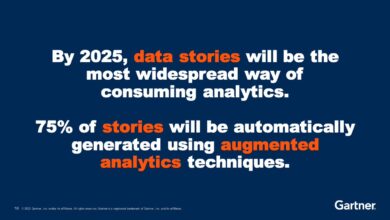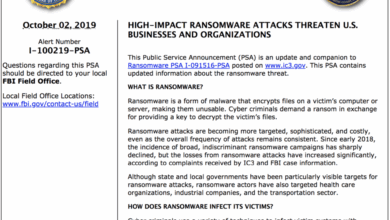
Data Privacy Concerns Erupt With Robotic Vacuums
Data privacy concerns erupt with robotic vacuums – who knew our floor-cleaning helpers could be such a privacy minefield? These seemingly innocent little robots, diligently mapping our homes and sucking up dust bunnies, are quietly collecting a surprising amount of data about our lives. From detailed floor plans to the location of our most prized possessions (and maybe even our sleeping habits!), the information these devices gather raises serious questions about data security and the potential for misuse.
This post dives into the fascinating – and slightly unnerving – world of robotic vacuum data privacy.
We’ll explore the types of data collected, how it’s stored and protected (or not!), and what the implications are for our privacy. We’ll also look at what manufacturers are doing (or failing to do) to address these concerns, and what you can do to protect yourself. Get ready to vacuum up some knowledge!
Data Collection Practices of Robotic Vacuums
The increasing popularity of robotic vacuums has brought with it a growing awareness of the data these devices collect and how that data is handled. While offering convenience and efficiency, these smart home devices raise important questions about privacy and data security. Understanding the types of data collected, how it’s stored, and the security measures in place is crucial for informed consumer choices.
Types of Data Collected by Robotic Vacuums
Robotic vacuums collect a surprising amount of data during their operation. This data is used to improve cleaning efficiency, create maps of your home, and, in some cases, to offer additional smart home integration features. Commonly collected data includes mapping data, which creates a digital representation of your home’s floor plan; cleaning patterns, showing the paths the vacuum takes during cleaning cycles; and obstacle detection data, which records the location and type of objects the vacuum encounters.
More advanced models might also collect data on things like air quality or even the presence of specific objects within the home. This data, while seemingly innocuous, can potentially reveal detailed information about your lifestyle and living space.
Data Storage and Security Measures
The methods for storing and securing this data vary significantly between manufacturers. Many companies store data on their own servers, using encryption to protect it from unauthorized access. However, the level of encryption and the security protocols employed can differ substantially. Some manufacturers offer users more control over their data, allowing them to delete it or limit its collection, while others provide less transparency and control.
Furthermore, the physical security of these servers and the robustness of the company’s cybersecurity measures are critical considerations. Data breaches, though rare, are a possibility, highlighting the importance of choosing a brand with a strong commitment to data security.
Comparison of Data Collection Practices Across Brands
Different robotic vacuum brands adopt varying approaches to data collection and privacy. Some prioritize user control and transparency, clearly outlining what data is collected and how it’s used. Others are less forthcoming, making it difficult for consumers to fully understand the implications of using their products. This lack of transparency can be a significant concern for privacy-conscious individuals.
Factors like the ability to delete collected data, the level of data encryption used, and the company’s data privacy policy should all be carefully considered when making a purchase.
Data Collection, Storage, and Security Comparison Table
| Brand | Data Collected | Storage Method | Security Measures |
|---|---|---|---|
| iRobot (Roomba) | Mapping data, cleaning patterns, obstacle detection, potentially air quality (depending on model) | Cloud storage with encryption | Data encryption, access controls, privacy policy |
| Roborock | Mapping data, cleaning patterns, obstacle detection, potentially room recognition | Cloud storage with encryption, option for local storage | Data encryption, access controls, regular security audits, privacy policy |
| Ecovacs | Mapping data, cleaning patterns, obstacle detection, potentially object recognition | Cloud storage with encryption, option for local storage on some models | Data encryption, access controls, privacy policy |
Data Privacy Policies and User Consent
Robotic vacuums, while offering convenience, raise significant data privacy concerns. Understanding the data privacy policies of manufacturers and the methods used to obtain user consent is crucial for informed consumer choices. This section will analyze these policies, highlighting areas of concern and proposing improvements.
Major robotic vacuum manufacturers, such as iRobot, Roborock, and Ecovacs, all collect data from their devices. This data can include mapping information of your home, cleaning schedules, and even potentially sensitive information like the location of furniture and personal belongings. However, the clarity and comprehensiveness of their data privacy policies vary considerably.
So, robotic vacuums are raising serious data privacy flags – mapping our homes and potentially sharing that info. This highlights the urgent need for robust security measures, especially in the cloud, which is why I’ve been researching bitglass and the rise of cloud security posture management – it’s crucial for protecting sensitive data, no matter the source.
Think about it: if our floor plans are vulnerable, what else is at risk? We need better safeguards across the board.
Analysis of Data Privacy Policies
The policies often use complex legal jargon, making them difficult for the average consumer to understand. Many policies lack specific details about the types of data collected, how it’s used, who it’s shared with, and how long it’s retained. For instance, some policies mention “aggregated data” but don’t explicitly define what constitutes aggregation or how this data is anonymized.
This lack of transparency raises concerns about potential misuse of collected data. Further, the policies’ descriptions of data security measures are often vague, lacking specifics on encryption methods or other safeguards employed.
Methods of Obtaining User Consent
User consent for data collection is typically obtained through a lengthy terms of service agreement during the initial device setup. Users are often presented with a long document that they must accept to use the device. This approach often fails to ensure genuine informed consent, as most users likely do not thoroughly read these lengthy agreements. Instead, consent is often implied through the act of proceeding with the setup process.
Some manufacturers also collect data through optional features, but the opt-out process for these features may be buried within the settings and not clearly communicated.
Proposed Sample User Consent Form
A more transparent and user-friendly approach is needed. A streamlined consent form could significantly improve the process. This form should clearly and concisely explain:
The types of data collected (e.g., floor plans, cleaning schedules, error logs).
The purpose of data collection (e.g., improving device functionality, providing customer support).
The recipients of the data (e.g., the manufacturer, third-party service providers).
The duration of data retention.
The user’s rights regarding their data (e.g., access, correction, deletion).
Contact information for data privacy inquiries.
Example Consent Statement: “By using this robotic vacuum, you consent to the collection and processing of data as described in our Privacy Policy. You understand that this data may include floor plans, cleaning schedules, and device performance information. This data is used to improve product functionality and provide customer support. You can access, modify, or delete your data at any time by contacting us at [email address]. Our full Privacy Policy is available at [link to policy].”
Potential Misuse of Collected Data

The seemingly innocuous task of cleaning your floors with a robotic vacuum actually generates a surprising amount of data. While manufacturers often claim this data is used solely for improving their product, the potential for misuse is a significant privacy concern. This data, including floor plans, object recognition, and even the times you’re home, could be vulnerable to exploitation in various ways, leading to serious privacy violations.The collection of this data, while often presented as beneficial for functionality improvements, opens doors to potential misuse that extends beyond the manufacturer’s stated intentions.
Consider the implications of a data breach, the potential for targeted advertising based on your lifestyle habits, or even the possibility of unauthorized access to your home’s layout. These are not theoretical risks; they represent genuine vulnerabilities that require careful consideration and robust security measures.
Unauthorized Access and Data Breaches
Robotic vacuum cleaners, like any internet-connected device, are susceptible to hacking. A successful breach could expose sensitive data like detailed floor plans of your home, revealing potential security weaknesses to malicious actors. Imagine a burglar using this information to plan a robbery, knowing precisely the layout of your home, including the location of valuables and blind spots. Furthermore, the data collected on your daily routines – when you leave and return home – could be exploited to time burglaries effectively.
Such breaches highlight the critical need for strong security protocols and regular software updates to protect user data.
Targeted Advertising and Profile Building
The data collected by robotic vacuums can be used to build detailed profiles of users. This information, combined with data from other sources, could be leveraged for highly targeted advertising. For example, a company might infer your lifestyle based on the size and layout of your home, the frequency of cleaning cycles, and the types of objects detected.
This data could then be used to send you personalized ads for products or services deemed relevant to your perceived lifestyle, even if you haven’t explicitly consented to such targeted advertising. This kind of profiling can feel invasive and raise ethical questions about the boundaries of data usage.
Vulnerabilities in Data Security Protocols
Many robotic vacuums rely on weak security protocols, including easily guessable default passwords and insufficient encryption. These weaknesses make them vulnerable to attacks. A lack of robust authentication mechanisms could allow unauthorized access to the device and its collected data. Moreover, inadequate data encryption could expose sensitive information during transmission or storage. These vulnerabilities, often compounded by a lack of regular security updates, create a significant risk to user privacy.
Potential Security Risks and Mitigation Strategies, Data privacy concerns erupt with robotic vacuums
The following points Artikel some potential security risks associated with robotic vacuum data and corresponding mitigation strategies:
- Risk: Data breaches exposing floor plans and routines. Mitigation: Strong passwords, two-factor authentication, regular software updates, and secure data encryption.
- Risk: Unauthorized access to device settings and data. Mitigation: Secure network configurations, robust access controls, and encryption of data both in transit and at rest.
- Risk: Use of collected data for targeted advertising without explicit consent. Mitigation: Transparent data privacy policies, clear consent mechanisms, and user control over data sharing options.
- Risk: Weak security protocols, such as default passwords. Mitigation: Manufacturers should implement strong default security settings and encourage users to change passwords immediately upon setup.
- Risk: Lack of data anonymization and aggregation. Mitigation: Implement data anonymization techniques to protect user identity while still allowing for data analysis and improvement of the product.
Data Security and Encryption
The security of data collected by robotic vacuums is a crucial aspect of privacy. While the convenience of automated cleaning is undeniable, understanding how manufacturers protect this data is vital for informed consumer choices. This section delves into the encryption methods employed, compares security features across models, examines manufacturers’ roles, and Artikels steps users can take to enhance security.The encryption methods used to protect data collected by robotic vacuums vary significantly depending on the manufacturer and the specific model.
Seriously, the data privacy implications of robotic vacuums mapping our homes are freaking me out! It’s a whole new level of surveillance, and it makes me wonder about the security of the apps controlling them. Building secure and reliable apps like this requires careful consideration, which is why I’ve been reading up on domino app dev, the low-code and pro-code future , to understand how to better protect user data.
Hopefully, advancements in app development will lead to better privacy controls for these increasingly common household robots.
Some manufacturers utilize end-to-end encryption, meaning that the data is encrypted on the device itself and remains encrypted throughout transmission and storage. Others may use transport layer security (TLS) or similar protocols to protect data during transmission, but the data may be stored in an unencrypted format on the manufacturer’s servers. The level of encryption employed directly impacts the data’s vulnerability to unauthorized access.
For example, a vacuum using AES-256 encryption offers a higher level of security than one using a weaker encryption algorithm.
Encryption Methods Used by Robotic Vacuum Manufacturers
Many manufacturers employ various encryption techniques, but specifics are often not publicly disclosed. This lack of transparency makes it difficult for consumers to compare the security features of different models. Generally, stronger encryption methods, such as AES-256, offer better protection against unauthorized access. However, the overall security of the system also depends on the security of the manufacturer’s servers and data handling practices.
Robust security protocols are essential to prevent data breaches. The absence of detailed, publicly available information on encryption methods highlights a need for greater transparency from manufacturers.
Comparison of Security Features Across Robotic Vacuum Models
A direct comparison of security features across different robotic vacuum models is challenging due to the lack of standardized reporting. Some manufacturers highlight features like secure Wi-Fi connections or data anonymization techniques, but the precise technical details are often omitted. Consumers should look for evidence of security certifications or independent security audits, although these are not always readily available.
Comparing models based solely on advertised features can be misleading without understanding the underlying technical implementation. For instance, a model advertising “secure cloud storage” might not specify the encryption method used, leaving its true security level unclear.
Manufacturers’ Role in Ensuring Data Security
Manufacturers bear the primary responsibility for ensuring the security of data collected by their robotic vacuums. This includes implementing robust encryption methods, securing their servers against unauthorized access, and adhering to data privacy regulations. Regular security audits and penetration testing are crucial to identify and address vulnerabilities. Manufacturers should also be transparent about their data collection and security practices, providing consumers with clear and accessible information about how their data is protected.
A proactive approach to security, including prompt patching of vulnerabilities, is vital for maintaining consumer trust.
Steps Users Can Take to Improve Robotic Vacuum Security
Users can take several steps to improve the security of their robotic vacuum. These include using strong and unique passwords for their vacuum’s Wi-Fi network and associated app, keeping the vacuum’s firmware updated, and enabling any available security features, such as two-factor authentication. Regularly reviewing the privacy settings within the associated app and limiting data sharing options can further enhance security.
Users should also be cautious about connecting their vacuum to unsecured Wi-Fi networks and avoid using public Wi-Fi for connecting to their vacuum’s app. Staying informed about security updates and best practices is essential for maintaining the security of their device and data.
Regulation and Legal Frameworks
The increasing sophistication of robotic vacuums and their ability to collect data about our homes raises significant concerns regarding data privacy. Understanding the existing legal frameworks and their application to this emerging technology is crucial for both consumers and manufacturers. This section explores relevant data privacy regulations and the challenges in their enforcement within the context of robotic vacuum data collection.
Several key regulations globally address data privacy, and their applicability to robotic vacuums varies depending on jurisdiction. These regulations often focus on transparency, user consent, data security, and the right to data access and deletion. However, the specific requirements and enforcement mechanisms differ, leading to a complex regulatory landscape.
Applicable Data Privacy Regulations
The General Data Protection Regulation (GDPR) in the European Union and the California Consumer Privacy Act (CCPA) in California are two prominent examples of comprehensive data privacy regulations. The GDPR, with its broad scope and stringent requirements, applies to any company processing personal data of EU residents, regardless of the company’s location. The CCPA, while narrower in scope, grants California residents significant rights regarding their personal data, including the right to know what data is collected, the right to delete data, and the right to opt-out of data sales.
Other jurisdictions have similar, though often less comprehensive, regulations.
Application of Regulations to Robotic Vacuum Data
The data collected by robotic vacuums, such as floor plans, object locations, and potentially even audio and video data depending on the model, can be considered personal data under many data privacy regulations. This is because this information can be used to infer details about the occupants’ lifestyle, habits, and even their absence from home. Therefore, manufacturers must comply with regulations regarding data collection, storage, processing, and security.
This includes obtaining explicit consent from users, providing clear and concise privacy policies, and implementing robust security measures to protect the data from unauthorized access or breaches.
Challenges in Enforcing Data Privacy Regulations
Enforcing data privacy regulations in the context of robotic vacuums presents several unique challenges. First, the sheer number of manufacturers and the global nature of the market make it difficult for regulatory bodies to effectively monitor compliance. Second, the technical complexity of the data collection and processing involved can make it challenging to determine whether a manufacturer is complying with the letter and spirit of the law.
Third, the evolving nature of technology means that regulations may struggle to keep pace with the rapid innovation in robotic vacuum technology. Finally, international harmonization of data privacy regulations is lacking, creating inconsistencies and complexities for companies operating across multiple jurisdictions.
Summary of Key Data Privacy Regulations
| Regulation | Key Aspects | Implications for Robotic Vacuum Manufacturers | Enforcement Challenges |
|---|---|---|---|
| GDPR (EU) | Consent, data minimization, data security, right to access/deletion | Must obtain explicit consent, implement robust security, comply with data subject requests | Jurisdictional complexity, enforcement across multiple countries |
| CCPA (California) | Right to know, right to delete, right to opt-out of data sales | Must provide transparency about data collection, offer data deletion options, avoid selling data without consent | Defining “sale” of data, enforcement across a large state |
| Other Regional/National Laws | Vary widely; often include principles of transparency, consent, and data security. | Manufacturers must comply with specific requirements in each relevant jurisdiction. | Complexity of navigating diverse legal landscapes. |
User Awareness and Education: Data Privacy Concerns Erupt With Robotic Vacuums

Let’s be honest, most people buying a robotic vacuum cleaner aren’t thinking about the potential privacy implications. They’re focused on convenience and a cleaner floor. This lack of awareness is a significant problem, and bridging this gap is crucial to responsible use of this increasingly popular technology. We need to move beyond the assumption that users implicitly consent to data collection simply by purchasing and using the device.The current level of user awareness regarding data privacy concerns related to robotic vacuums is low.
Many users are unaware of the extent of data collected, how it’s used, and the potential risks involved. Marketing materials often highlight features and convenience but rarely delve into the privacy implications. This leaves consumers largely in the dark, making informed decisions about their privacy nearly impossible.
Educating Users About Data Privacy Concerns
Effective user education requires a multi-pronged approach. Manufacturers should be transparent about their data collection practices, providing clear and concise information in easily understandable language, not just buried deep within lengthy terms of service agreements. This information should be readily available on the product packaging and website, and easily accessible within the accompanying app. Independent consumer advocacy groups and technology news outlets can play a vital role in raising awareness through articles, videos, and social media campaigns.
These campaigns should highlight real-world examples of potential privacy violations, emphasizing the importance of user control and data security.
Recommendations for Protecting User Privacy
Users can take several steps to mitigate privacy risks associated with robotic vacuums. Firstly, carefully review the manufacturer’s privacy policy before purchasing a device. Pay close attention to what data is collected, how it’s used, and with whom it’s shared. If the policy is unclear or concerning, consider choosing a different product. Secondly, users should opt out of any data sharing options that they are uncomfortable with.
Many manufacturers offer settings to limit the amount of data collected or disable features that involve data transmission. Finally, regularly update the firmware of your robotic vacuum and its accompanying app to benefit from the latest security patches.
Visual Representation of Data Flow and Vulnerabilities
Imagine a diagram. At the left, we have the robotic vacuum itself. Arrows show data flowing from it: first, to the user’s home Wi-Fi network (potential vulnerability: unsecured network allows interception). Then, the data travels to the manufacturer’s cloud servers (potential vulnerability: data breaches, insecure servers). From there, arrows branch out showing various uses: mapping services (potential vulnerability: sensitive floor plan data compromised), performance analysis (potential vulnerability: data used to identify personal habits), and potentially marketing and third-party data sharing (potential vulnerability: data sold or misused).
Finally, an arrow indicates feedback loops: from the servers, updates and instructions are sent back to the vacuum (potential vulnerability: malicious code injected into updates). This illustrates the multiple points where data can be compromised.
Conclusion
So, are robotic vacuums worth the potential privacy risks? That’s a question each individual needs to answer for themselves. While the convenience they offer is undeniable, the potential for data misuse is a serious consideration. By understanding the data collection practices of these devices, and by taking proactive steps to mitigate potential risks, we can all navigate this new technological landscape with a greater sense of control over our personal information.
Let’s keep the conversation going – what are your thoughts on robotic vacuum data privacy?
FAQ Guide
What happens to the map my robot vacuum creates of my home?
The map’s fate depends on the manufacturer and your settings. Some companies store the map on their servers, while others process it locally on the device. Check your vacuum’s privacy settings and the manufacturer’s policy to understand how your data is handled.
Can my robotic vacuum be hacked?
Like any connected device, robotic vacuums are vulnerable to hacking. Weak security protocols and unsecured Wi-Fi networks can create entry points for malicious actors. Keeping your router’s password strong and regularly updating your vacuum’s firmware are crucial security measures.
Do I need to worry about my robotic vacuum listening to my conversations?
While most robotic vacuums don’t have microphones specifically designed for voice recording, some models may inadvertently pick up sounds as part of their obstacle detection system. This data is usually not actively recorded or stored, but it’s still something to be aware of.





